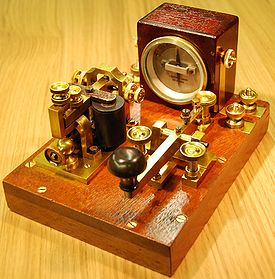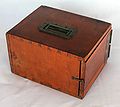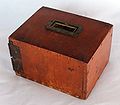Field Telegraph Baseboard Set
| Field Telegraph Baseboard Set | |
|---|---|
 A refurbished Baseboard Set | |
| Service history | |
| Wars | First World War |
Description
These sets, functionally described as a "Direct Working Single Current Intermediate Baseboard Set", were made-up by Royal Ordnance Factories and a few commercial suppliers (including Gilbert Brothers) and consisted of standard commercial components. The three components were a Pattern 1056A key, a 300 Ohm GPO model sounder and lineman's galvanometer (a modified "Detector, Q & I") all affixed to a wooden baseboard and interconnected underneath. A wooden carrying case featuring a metal carrying handle, a side-hinged front door and internal wooden guides to insert the baseboard was provided.
The board has four connections - on the right rear "C" (Carbon) and "Z" (Zinc) to connect to the local cells/battery postive and negative leads respectively (carbon and zinc were the electrode materials in the early wet (Leclanche) cells of the era) while on the left rear are "L" (Line) to connect to the telegraph line and "E" (Earth) to connect to a ground spike. During operation, the galvanometer indicates if a signal is on the line, either being received or transmitted. While in 'listening' mode the sounder, in series between the galvanometer and ground, makes audible sounds of the received signal. When 'sending', pressing the key takes the sounder out of the circuit and connects the cells/battery to the line thus transmitting power onto the line.
Related Pages
- No related pages at this time
Related Items
See Also
- M0DVO - Small Military Field Telegraph Set (a restored unit)
- Neal McEwen, K5RW, Foreign Key Photo Gallery
- W1TP Telegraph Key Museum - Set 1755







